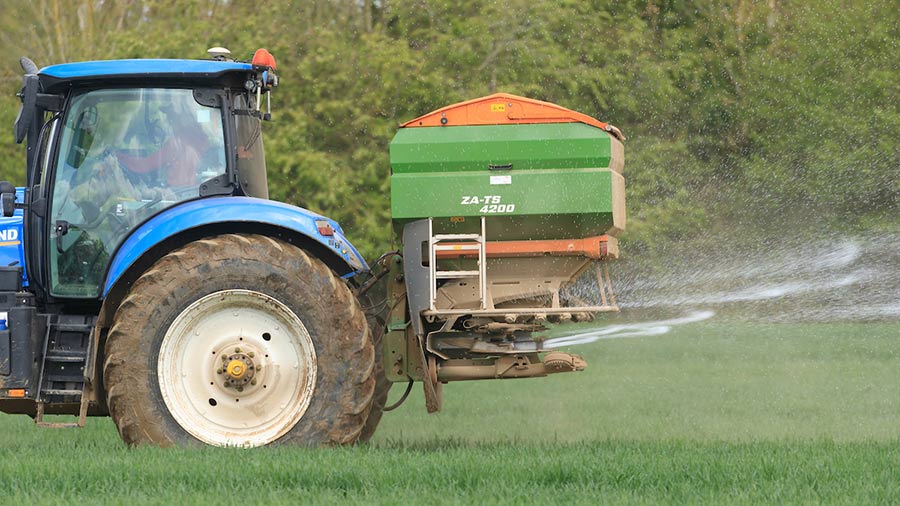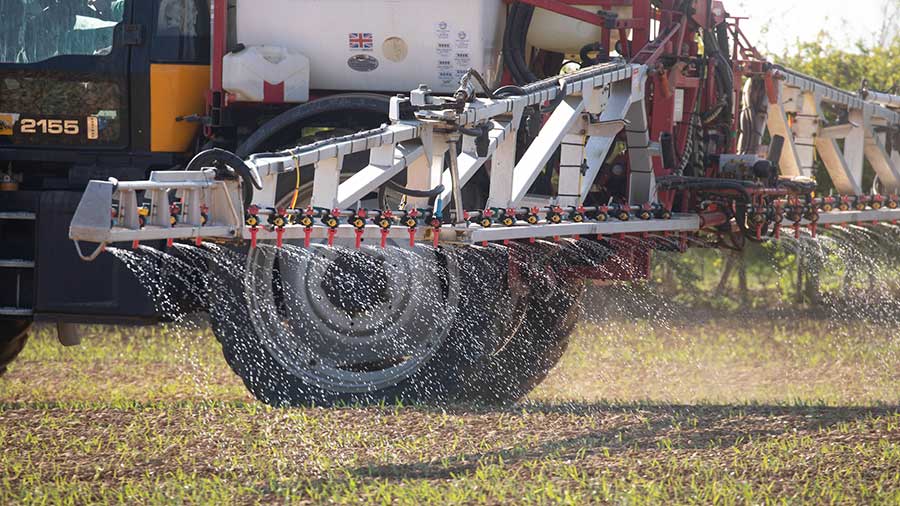Why urea fertiliser use is changing this spring
 © Tim Scrivener
© Tim Scrivener Farmers are being reminded that a new, non-regulatory approach to urea fertiliser use will be implemented this season, as part of the government’s efforts to tackle air pollution and improve air quality.
In a move designed to reduce ammonia emissions from agriculture, a stewardship scheme developed by an industry consortium to limit the volatilisation losses from applied urea fertilisers will start on 1 April 2024.
See also: Big savings in fertilisers can be made by utilising manures
In summary, it stipulates that urea fertilisers applied on or after 1 April must include a urease inhibitor.
Before that date, from 15 January to 31 March, urea applications do not need to include an inhibitor, as ammonia losses from their use are negligible in colder, wetter conditions.
Current exemptions
The new guidance only applies to England and affects any fertiliser that contains 1% or more of urea and is soil-applied.
Fertilisers that are incorporated in the soil – such as with potatoes and vegetable crops – are exempt.
A slightly grey area is the use of liquid urea/ammonium nitrate fertilisers. These can still be used without an inhibitor after 1 April if there is agronomic justification for doing so and proof that ammonia losses will be very low – as agreed by a Facts adviser.
Liquid fertiliser and crop specialist Omex’s R&D manager, David Booty, says: “In addition, foliar-applied urea products are outside of the scope of this scheme. Emissions from foliar applications are not considered to be an issue.”
The new scheme is a self-policing approach, he confirms, but stresses that the government is looking for a 70% reduction in emissions from the use of granular and compound fertilisers containing urea.

© Tim Scrivener
What’s the problem with urea?
Following application, urea fertilisers break down rapidly to ammonia, helped by the naturally occurring enzyme urease.
This increases the pH and promotes ammonia loss, although actual losses vary widely and depend on temperature, rainfall, soil type and growing conditions.
Ammonia is an air pollutant, affecting both the environment and human health.
Where volatilisation does take place and ammonia emissions occur, there’s a risk to the public from particulate matter and to wildlife from the acidification of soils and eutrophication of habitats and water bodies.
Scheme administration
“It hasn’t been enshrined in law, but it has been made quite clear that legislation will be introduced if the scheme doesn’t produce the required results,” says David.
“Having initially proposed a ban on the use of urea, there has been a compromise reached after a great deal of work.
“It’s now up to everyone involved to make sure that it works and we all see a social benefit from the outcome.”
It will be administered by Red Tractor, with farm inspections including records of responsible fertiliser use.
In addition, all fertiliser distributors and suppliers will be asked to send in returns on sales, while the British Survey of Fertiliser Practice will also play a role in providing the necessary information.
Inhibitor effectiveness
One issue that growers need to be aware of is that there are various compounds which are called urease inhibitors, says David.
“Having tested quite a few of them, the results varied widely. We saw a range in their effectiveness – some only reduced emissions by 20%, others were much better at 80%.”
In the absence of any standards or certification, farmers must be prepared to challenge suppliers about their effectiveness and ask to see independent data on how different products perform, he advises.
“The most commonly used compound is known as NBPT [N-(n-butyl) thiophosphoric triamide].
“It’s proven, and there have been plenty of trials done to show that it works well.”
What is an urease inhibitor?
Urease inhibitors are compounds that block the activity of the urease enzyme, slowing the conversion of urea to ammonia.
They degrade in the soil over time, so delaying the conversion process rather than preventing it completely – resulting in a slow release of the nutrient and better uptake by the crop.
They should not be confused with nitrification inhibitors, which are used to delay the nitrification process – which is when ammonium is converted to nitrate in the soil.
A longer, slower conversion process reduces the potential for leaching.
Achieving emission reductions
As a result, it’s the inhibitor of choice for a number of suppliers, he reports.
“Remember, Defra wants to see a 70% reduction for good reasons – agriculture currently accounts for 88% of the UK’s ammonia emissions.”
He adds that the better inhibitors all work in the same way, providing enough is put on.
“A higher rate would be used in a high-risk situation – perhaps where you have exposed soil in dry conditions, or a high pH chalky soil.
“A lower rate is justified in that you have good ground cover in the field and the soil conditions are cool and damp.”
Some inhibitors contain more than one compound, claiming that a combination gives better results.
“Either way, it’s largely the same technology and the molecules used are very similar.”
Economic and social benefit
David makes the point that there is an economic benefit from using an inhibitor, with any additional costs being covered by a 0.2-0.3t/ha yield benefit.
“It pays for itself and helps to provide a public good.
“We’re all aware of the emphasis being put on the natural environment, so this is a chance for the industry to improve on current practice and show that it wants to do the right thing.”
There’s a big chunk of urea fertiliser used early in the season, from February up to the end of March, with the switch then being made to ammonium nitrate once the weather conditions have changed.
While liquid fertiliser users are able to purchase inhibitors separately, adding them to the tank at the time of application, solid users have to plan their purchases carefully to avoid falling foul of the new approach.
That’s especially relevant, given the forward nature of nitrogen buying and recent disruption in the fertiliser market.
The cost of including an inhibitor works out at around £5-£10/ha, depending on the fertiliser being used.
Are there any soil health implications?
Teagasc, which carried out a five-year research project in grassland in Wexford, Ireland, found that soil bacteria and fungi communities were not affected by the long-term use of urease inhibitors.
Led by Dr Aoife Duff and Dr Patrick Forrestal, the work confirmed that microbial function and the abundance of nitrogen cycling communities were mainly unaffected by fertiliser or inhibitors.
Overall, the study found that fertilisation had a greater effect on the microbial community than the impact of inhibitor use.

